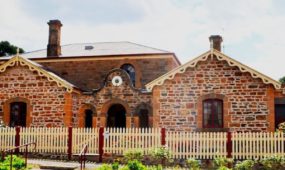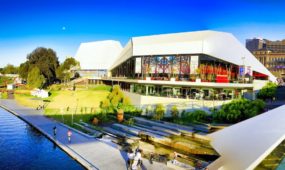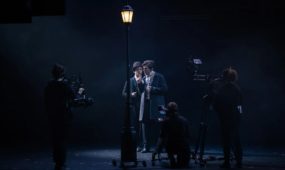A tale of two cities: two young Australian jewellers make their mark
Arts
TWO exciting jewellery exhibitions opened simultaneously last week, one in Sydney and one in Adelaide. These exhibitions involve two young Australian jewellers who make very different work, both conceptually and visually.

Sign up to receive notifications about new stories in this category.
Thank you for subscribing to story notifications.
In her solo Sydney exhibition, Building Jewellery, Jessamy Pollock draws inspiration from Australian architecture, the built environment, and patterns that occur in nature, using aluminium and precious metals.
And in Adelaide Lisa Furno, who crafts jewellery from rubbish and found objects, has for the first time acted as sole curator of a jewellery exhibition of works by New Zealand artists, titled outbursts of unhinged imagination.
The work of these two young jewellers represents a generational shift, marked by the increasing vernacularisation of Australian visual art, including jewellery.
In this context, vernacularisation means a rejection of clichéd Australianness – references to the bush and the beach, for example – and more direct engagement with aspects of urban and suburban living: art and design reflecting our everyday lives and domestic concerns.
Despite the two young artists' very real differences of approach, and choice of media, the artistic oeuvres of both are imbued with this vernacular sensibility.
Pollock’s wearable sculptures reflect high levels of planning, control, and detailed attention to form and line. She makes refined works that reside comfortably within the fine art paradigm.
On the other hand, bowerbird-like, Lisa Furno uses junk and throwaway materials to create tongue-in-cheek, ironic work by melting down plastics and incorporating other collected detritus. Furno alchemically transforms these unprepossessing raw materials into colourful and flamboyant wearable collages that by some small miracle seem to transcend the fine art/popular culture divide.
By contrast, Jessamy Pollock’s artwork deliberately references naturally occurring patterns and repetitions, such as the honeycomb, as well as the geometric designs in certain Australian architecture:
I began looking at Federation Square for aesthetic inspiration some years ago, which started me reading essays about the design philosophies behind buildings.
In this she has been inspired by the work of Donald Bates, the lead designer of the Federation Square redesign, who has written about the underlying philosophy of his LAB Architecture Studio group’s practice in the following terms:
It is our belief as architects that the social dimension of space lies in its ability to be materialised and conceptualised by means of new and evermore speculative spatial orderings.
Bates et al’s architectural philosophy has profoundly influenced Jessamy Pollock’s jewellery practice. In her own words, she elaborates the basic principles underpinning her practice, as derived from that source, the first of which is that:
Every thing must have two purposes. This can mean in the broader sense that the building is both a shelter and a sculpture. In the case of jewellery, it needs to be wearable but also, away from the body, it must be a sculpture in its own right.
Pollock’s wearable sculptures also bear witness to Australian urbanity and sub-urbanity, and to the interconnected world in which we now live.
Traditional notions of jewellery speak to hierarchical regimes within status-conscious societies, evoking powerful, heavily bejewelled personages. This sits uneasily with the resilient Australian self-image of egalitarianism.
While the idea that Australians universally eschew power, prestige, and status is nothing short of self-deception, we have sufficiently overcome our collective cultural cringe to appreciate the power of the vernacular in life and in art. This increasingly informs our developing tastes in visual art, including bodily adornment.
Many of Pollock’s clever, captivating brooches and other “wearable art” pieces are small-scale models of the unique, eccentric, crazy-shaped architecture of Melbourne’s Federation Square, each brooch taking its individual shape from the angle of observation from that precinct.
Not only does this involve conceptual prowess but Pollock’s body of work always evinces a high level of technical mastery. At the same time the design elements underpinning these wearable sculptures tap into what could be deemed a distinctively Australian social and architectural zeitgeist.
As the architect John Macarthur writes about Federation Square:
To consider the merit of Federation Square is to consider how effectively this common space of the Public is tied up in the game of culture.
Jessamy Pollock, also tied up in “the game of culture”, goes beyond designing and making exquisite maquette brooches and earrings featuring Federation Square. In her Sydney exhibition, Building Jewellery, she’s created an entire suite of wearable art housed within custom-made glass domes, itself a way of imagining Australian culture differently. At the same time each individual work that resides inside these little cultural hothouses is entirely legible as bodily adornment.
Lisa Furno’s modus operandi is entirely different, but no less connected to the time and place in which we find ourselves living.
Furno’s mastery lies in her uncanny ability to transform rubbish, mainly plastics, into wearable objects. To quote the Australian poet Kenneth Slessor in an entirely different context: “You find this ugly, I find it lovely.”
Furno is the Recycling Queen of contemporary Australian jewellery. Through her practice she’s indirectly and lightheartedly referencing our collective social concerns about industrial waste, the environment, and the future of this place that we now share.
Furno explains her approach to the wild, oft-dramatic and hyperreal artworks that she creates, the antithesis of conventional jewellery, in the following way:
I take a playful, energetic and whimsical view to life and like to express this approach in my work. I construct my practice with care but don’t want the concepts to be too serious.
Being a relentless collector my studio is full of found objects from various jaunts to far way places that inspire me. Roaming the world is essential to the heath of my practice and allows me to glean the vibrancy of places, people and cultures.
Because I use “unconventional” materials, an observer might not straightaway guess that the “lovely” neckpiece they are looking at was once a dildo. Recently it appears that textiles are more frequently finding their way into my practice. Sneaky.
I have a great fondness for colour, repetition and movement and believe that jewellery should be enjoyed, lived, talked about and worn.
In the cases of these young jewellers, both of whom have resided in NSW and SA at varying times, this vernacularisation of Australian jewellery is taking place without artistic recourse to the at-times clichéd imagery of yesteryear, and also without the slightest hint of nationalism.
Furno and Pollock are part of a creative succession, in part founded on the unselfconscious acknowledgement that we Australians are mostly city dwellers, or live in the ’burbs. No longer is it all about the bush and the beach, or the cultural practices of others who lived in distant places and times.
Both artists are “at home” in this place, and at this time in Australian history. Today, this also means being at home in the world, and knowledgeable about it. Their works speak eloquently to this.
It shows that there are commonalities in Australians' experience of the built environment, and in our collective concern for environmental issues more generally.
This creative succession is evident through Pollock and Furno’s artworks, although no proselytising accompanies this: first and foremost, they are artists, not preachers.
Both young artists leave audiences wanting more.
Outbursts of unhinged imagination runs until Sunday 1st November 2015; Building Jewellery continues until Saturday 31st October.
This article was originally published on The Conversation. Read the original article.
Jump to next article



